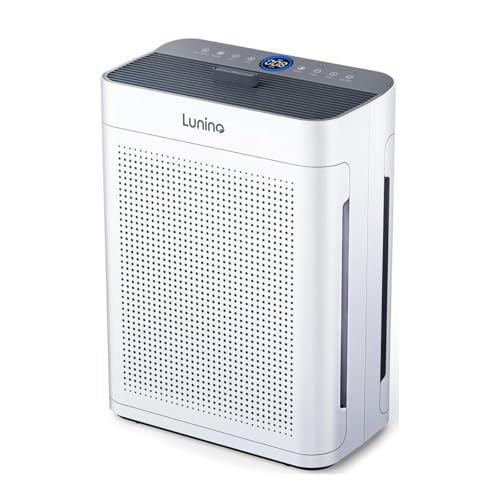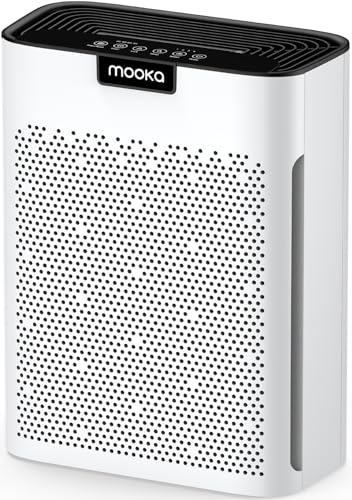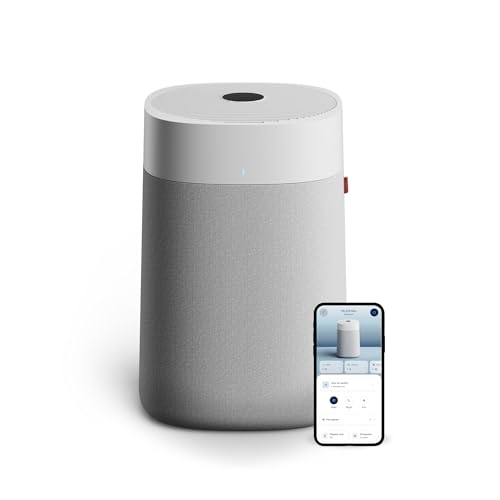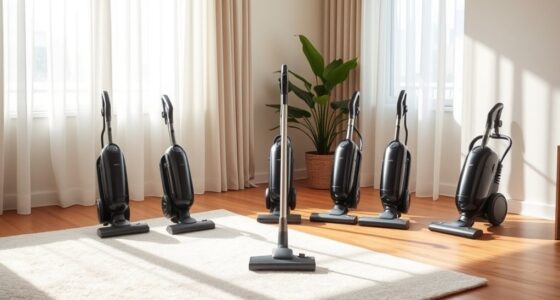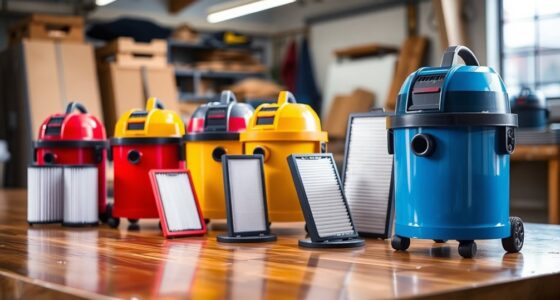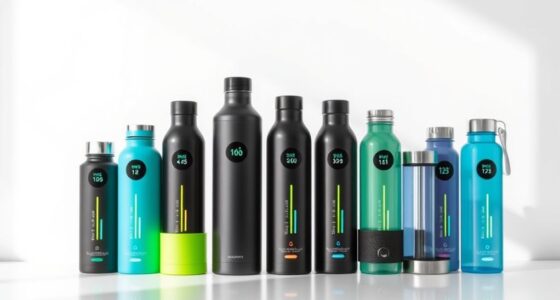If you’re looking for the best whole-house air purifiers to combat allergies, I recommend the LUNINO HEPA for its double-sided purification, or the MOOKA with its washable filter. The Blueair Blue Pure 211i Max is perfect for large spaces, while the LEVOIT Vital 100S-P offers smart features. Finally, the compact LEVOIT Core300-P is effective for various room sizes. Let’s explore features and benefits to help you choose the right one for your home.
Key Takeaways
- LUNINO HEPA Air Purifier: Ideal for large spaces, covers up to 3000 sq.ft with double-sided purification, ensuring quick allergen removal year-round.
- Blueair Blue Pure 211i Max: Efficiently purifies areas up to 3,048 sq.ft using HEPASilent tech, perfect for allergy sufferers seeking comprehensive coverage.
- MOOKA HEPA Air Purifier: Features a washable 3-stage filter, quiet operation, and effective allergen capture for maintaining clean air in larger homes.
- LEVOIT Vital 100S-P: WiFi-enabled purifier suitable for large rooms, offering effective allergen removal with smart features for convenient operation.
- Smart Features & Monitoring: Many models include air quality sensors, app control, and reminders for filter changes, enhancing ease of use and maintenance.
LUNINO HEPA Double-Sided Air Purifier for Large Rooms
If you’re looking for an effective solution to combat allergies in larger spaces, the LUNINO HEPA Double-Sided Air Purifier is a standout choice. Its double-sided air intake cleans the air twice as fast as traditional models, making it perfect for rooms up to 3000 sq.ft. With a powerful 3-stage filtration system, it captures 99.97% of allergens, including pet hair and pollen. Plus, the built-in air quality sensor automatically adjusts the fan speed for ideal performance. I love the quiet operation in Sleep mode, and the added aromatherapy feature lets me enjoy pleasant scents while breathing clean air.
Best For: Individuals suffering from allergies or those living in large spaces up to 3000 sq.ft. needing efficient air purification.
Pros:
- Double-sided air intake for faster purification compared to traditional models.
- 3-stage filtration system captures 99.97% of allergens and pollutants.
- Quiet operation in Sleep mode and an aromatherapy feature for added comfort.
Cons:
- Initial readings from the air quality sensor may be inaccurate until calibration is complete.
- Replacement filters may still incur costs despite the washable pre-filter.
- The size of the unit may not be suitable for smaller rooms or spaces.
MOOKA HEPA Air Purifier for Large Rooms (KJ190L)
For anyone dealing with allergies, the MOOKA HEPA Air Purifier for Large Rooms (KJ190L) stands out as an essential solution. It covers large spaces up to 2200 ft², ensuring clean air throughout your home. The advanced 3-stage washable filter captures particles as small as 0.3 microns, including pet dander and pollen. I love the energy-efficient design, operating quietly at just 20dB in sleep mode. Plus, the essential oil diffuser adds a pleasant touch. With a filter change reminder and child lock feature, this purifier combines functionality and safety, making it a great choice for families.
Best For: Those seeking an effective air purification solution for large rooms, particularly individuals with allergies, pet owners, and families with children.
Pros:
- High Efficiency: The 3-stage washable filter effectively captures small particles, improving air quality.
- Energy-Saving: Operates quietly and consumes minimal energy, making it cost-effective for continuous use.
- Multi-Functional: Includes an essential oil diffuser and customizable fan speeds for added comfort.
Cons:
- Size: Its large coverage area may not be necessary for smaller spaces, making it less versatile for compact rooms.
- Filter Replacement: Requires regular maintenance and filter changes, which may be inconvenient for some users.
- Initial Setup: Users must remember to remove the protective plastic from the filter before use, which can be overlooked.
BLUEAIR Air Purifier for Large Rooms (Blue Pure 211i Max)
Looking for an air purifier that can handle large spaces while effectively reducing allergens? The Blueair Blue Pure 211i Max is a fantastic choice. With HEPASilent technology, it cleans the air in up to 3,048 sqft in just 60 minutes, all while operating quietly, thanks to its Quiet Mark certification. It removes 99.97% of airborne particles down to 0.1 microns, including pet dander and pollen. I love its smart features like app scheduling and Alexa compatibility for hands-free control. Plus, with easy-to-use settings, maintaining great air quality has never been simpler. This purifier truly transforms indoor air.
Best For: Those seeking an efficient and quiet air purifier for large rooms that effectively reduces allergens and offers smart features for easy control.
Pros:
- Fast purification: Cleans large spaces (up to 3,048 sqft) quickly in just 60 minutes.
- High filtration efficiency: Removes 99.97% of airborne particles down to 0.1 microns, including allergens like pet dander and pollen.
- Smart features: Includes app scheduling, Alexa compatibility, and real-time air quality monitoring for convenient use.
Cons:
- Replacement filters required: Needs genuine replacement filters (Blue Pure F2MAX) for optimal performance, which can add to ongoing costs.
- Size: May be bulky for smaller spaces or apartments.
- Initial price: Higher upfront cost compared to basic air purifiers without advanced features.
LEVOIT Air Purifier for Home Large Room (Vital 100S-P)
The LEVOIT Air Purifier for Home Large Room (Vital 100S-P) is ideal for anyone seeking a powerful solution to combat allergies in spacious environments. It covers up to 1,073 sq.ft., making it perfect for open-concept spaces. With a 3-stage filtration system, it captures 99.97% of ultrafine particles, including pollen and pet dander. The smart WiFi connectivity allows me to control it via an app, monitor air quality, and set schedules. Its quiet operation, especially in Sleep Mode, ensures restful nights. Customers rave about its effectiveness in improving air quality and reducing allergens, making it a smart investment for healthier living.
Best For: Individuals seeking an effective air purifier to alleviate allergies and improve air quality in large rooms.
Pros:
- 3-stage filtration system captures 99.97% of ultrafine particles, improving air quality significantly.
- Smart WiFi connectivity allows for convenient control via a mobile app, including scheduling and real-time monitoring.
- Quiet operation in Sleep Mode ensures minimal disturbance during nighttime use.
Cons:
- The initial cost may be higher compared to basic air purifiers.
- Requires periodic replacement of HEPA and activated carbon filters, which can add to long-term maintenance costs.
- WiFi connectivity may not be as reliable in areas with weak internet signals.
LEVOIT Air Purifier for Home (Core300-P)
With its impressive coverage of up to 1,073 square feet, the LEVOIT Core 300-P air purifier stands out as an excellent choice for allergy sufferers seeking a powerful solution for cleaner indoor air. I love its compact size and sleek design, making it fit perfectly in any room. The 3-in-1 HEPA-grade filter captures 99.97% of allergens, including pollen and pet dander, providing noticeable air improvement within days. Plus, it operates quietly on sleep mode, ensuring I can rest undisturbed. With over 131,000 reviews and a 4.7-star rating, it’s a reliable option for anyone wanting fresher air at home.
Best For: Allergy sufferers, pet owners, and individuals seeking fresher, cleaner indoor air.
Pros:
- Compact and sleek design fits seamlessly into any room.
- Highly effective 3-in-1 HEPA-grade filter captures 99.97% of allergens.
- Operates quietly in sleep mode, allowing for undisturbed rest.
Cons:
- Some users report occasional headaches when running overnight.
- Requires filter replacement every 6–8 months for optimal performance.
- Higher settings can be slightly louder, which may not be ideal for all users.
Factors to Consider When Choosing Whole-House Air Purifiers for Allergies

When I think about choosing a whole-house air purifier for allergies, several factors come to mind. It’s crucial to take into account room size coverage, the efficiency of the filtration system, and how much noise it’ll make. I also weigh maintenance costs and whether it has any smart features that could make my life easier.
Room Size Coverage
Choosing the right whole-house air purifier for allergies hinges on understanding room size coverage. I always make sure the purifier’s coverage area matches the size of my home or the specific large room I want to purify, typically measured in square feet. For critical performance, I look for a model that can filter the entire space in 30-60 minutes, depending on the size. It’s essential to verify the CADR (Clean Air Delivery Rate) ratings, ensuring it can effectively circulate and filter the air. I also consider models with dual or multi-sided air intake designs, as they can manage larger volumes of air more efficiently. Finally, I always check the manufacturer’s recommended room size specifications to guarantee effective allergy relief.
Filtration System Efficiency
Understanding filtration system efficiency is essential for selecting the right whole-house air purifier to combat allergies. I’ve found that a highly efficient system often combines pre-filters, HEPA filters, and activated carbon filters. HEPA filters are crucial because they capture 99.97% of airborne particles as small as 0.3 microns, which means they’re great at reducing pollen, pet dander, and dust mites—common allergens in our homes. Activated carbon filters do wonders for absorbing odors and volatile organic compounds, enhancing indoor air quality. Pay attention to the MERV rating; filters rated between 13 and 20 excel at removing microscopic allergens. Finally, don’t forget that regular maintenance, like timely filter replacements, is vital for keeping the system running efficiently.
Noise Levels Consideration
After I’ve looked into filtration system efficiency, another important factor to regard is noise levels. I know how vital a quiet environment is, especially when I’m trying to sleep or focus on work. Ideally, I’d want a whole-house air purifier that operates below 30dB, with the best options running around 15-20dB. Fan speed settings can profoundly affect noise output, so I pay attention to those; higher speeds often mean louder sounds. Some purifiers have sleep modes that automatically reduce noise and dim lights, which I find incredibly helpful at night. Ultimately, design elements like blade type, motor quality, and sound insulation features can make a big difference in how quietly the unit operates, so I make sure to think about those as well.
Maintenance and Replacement Costs
When it comes to maintaining a whole-house air purifier, I can’t overlook the importance of understanding maintenance and replacement costs. Regularly replacing filters, like HEPA and activated carbon, is vital to keep air quality high. I’ve learned that washable pre-filters can extend the life of pricier filters, reducing overall costs. Some systems even have filter change indicators, which help me budget for replacements and avoid dips in performance. Replacement filters typically range from $20 to $80, so it’s wise to consider options with longer-lasting filters or multi-stage filtration. This choice not only decreases the frequency of replacements but also offers better value for long-term maintenance. Prioritizing this can make a significant difference in overall expenses.
Smart Features and Connectivity
Smart features and connectivity can truly elevate the experience of using a whole-house air purifier for allergies. With app control and voice command compatibility, I can operate and monitor the air quality remotely, which is super convenient. Integrating with smart home ecosystems like Alexa or Google Assistant means my purifier can automatically adjust based on real-time air quality data. I love how the built-in sensors provide continuous feedback, optimizing fan speeds and filtration settings without me lifting a finger. Plus, features like scheduling, filter change alerts, and geofencing make maintenance effortless. Best of all, smart-enabled purifiers track air quality trends, helping me manage allergy triggers more effectively. It’s all about making my home a healthier place to breathe!
Energy Consumption Rates
Choosing the right whole-house air purifier involves considering energy consumption rates, which can substantially impact your utility bills. Most purifiers consume between 30 to 150 watts, depending on their size and fan settings. I’ve found that energy-efficient models tend to run at lower power levels, helping to cut down on electricity costs over time. If you plan to operate the purifier continuously, look for one with adjustable fan speeds to optimize efficiency. The annual energy cost can vary markedly, from as low as $20 to over $100. Additionally, features like auto-shutoff, timers, and smart controls can minimize unnecessary operation, further reducing your energy consumption and keeping your bills in check.
Design and Aesthetics
Energy efficiency is just one aspect to contemplate; the design and aesthetics of a whole-house air purifier play a significant role in its overall appeal and functionality. I find that choosing a unit that seamlessly integrates with my home decor is essential. Sleek, unobtrusive designs or duct-mounted configurations can blend in effortlessly. Plus, I prefer models that operate quietly to maintain a peaceful environment. Compact or wall-mounted options help maximize space and reduce clutter, which is a plus. I also appreciate neutral colors and minimalist styles that don’t draw unwanted attention. Finally, easy-to-maintain features like accessible filters and simple control panels enhance both functionality and user convenience, making my life a little easier.
Additional Functionalities Offered
When considering a whole-house air purifier for allergies, it is essential to look beyond basic filtration capabilities. I’ve found that many models come equipped with smart features like app control and air quality monitoring, making it easier to manage indoor air quality. Some even have integrated aromatherapy functions, allowing me to add essential oils for a pleasant scent. Advanced purifiers often include multi-speed fan modes and auto-adjustments based on real-time air quality data, which I appreciate. Additionally, I’ve noticed that certain units offer extra filtration stages like activated carbon for odor removal and UV light for microbial inactivation. Finally, energy-efficient designs with programmable timers help keep my energy costs low while ensuring continuous operation.
Frequently Asked Questions
How Often Should I Replace the Filters in My Air Purifier?
I usually replace the filters in my air purifier every three to six months. However, it really depends on how often I use it and the air quality in my area. If I’ve got pets or allergies, I tend to change them more frequently. I check the manufacturer’s guidelines too, since they often provide specific recommendations. Keeping the filters fresh helps guarantee I’m breathing the cleanest air possible!
Can Air Purifiers Help Reduce Pet Dander and Odors?
Absolutely, air purifiers can help reduce pet dander and odors! I’ve noticed a significant difference since I started using one in my home. They capture airborne particles, including pet allergens, which helps improve the overall air quality. Plus, some models use activated carbon filters specifically designed to tackle odors. If you’re a pet owner like me, investing in a good air purifier is definitely worth it for a fresher, cleaner living space!
Do Air Purifiers Consume a Lot of Electricity?
Air purifiers typically don’t consume a lot of electricity. In fact, most models use about the same energy as a standard light bulb. I’ve found that running mine consistently has minimal impact on my energy bill. Of course, it varies by model, so I’d recommend checking the specifications for the one you’re considering. Overall, the benefits of cleaner air definitely outweigh the slight increase in electricity use.
Are There Any Maintenance Tips for Prolonging Air Purifier Life?
To prolong my air purifier’s life, I’ve found a few key maintenance tips really help. I regularly change the filters as recommended, usually every 3-6 months. I also clean the unit’s exterior with a damp cloth to remove dust. It’s important to keep the air intakes clear, so I make sure there’s no obstruction around the purifier. Finally, I schedule a yearly deep clean to keep everything running smoothly.
Can I Use an Air Purifier While Sleeping?
Absolutely, I use my air purifier while sleeping, and I find it really helpful! It runs quietly, so it doesn’t disturb my rest. Plus, I wake up feeling refreshed and breathe easier throughout the night. I recommend checking the noise level of the model you choose, just in case. Keeping it on helps filter out allergens and pollutants, ensuring a cleaner environment for a good night’s sleep.
Conclusion
As I wrap up this exploration of the best whole-house air purifiers for allergies, I can’t help but wonder: which one will you choose to transform your home into a sanctuary? Each option brings its unique strengths, but the right fit might just be the missing piece in your quest for relief. Imagine breathing easy, free from allergens that once plagued your space. The decision is yours, and the air quality you crave is tantalizingly close—are you ready to take the plunge?


